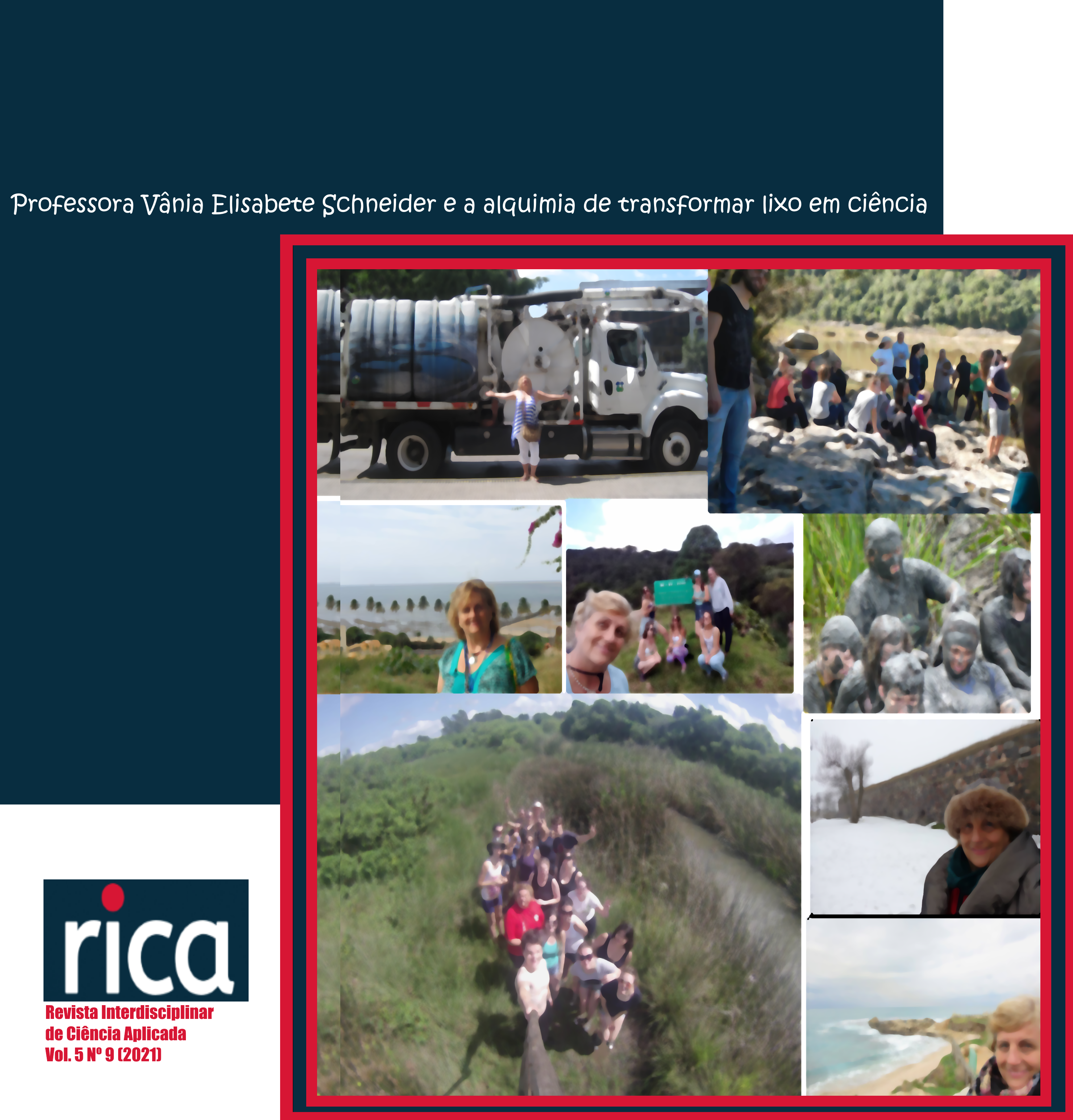Antifungal activity of Baccharis trimera and Foeniculum vulgare essential oils for control of bitter rot in apple
DOI:
https://doi.org/10.18226/25253824.v5.n9.06Keywords:
Colletotrichum fructicola, alternative control, essential oil, Malus domesticaAbstract
The present study aimed was to determine the chemical composition of Baccharis trimera and Foeniculum vulgare essential oils (EOs) and their in vitro and in vivo effect against Colletotrichum fructicola, the causal agent of bitter rot in apple. Chemical composition of EOs was determined by GC-MS and their effect against C. fructicola was evaluated in vitro by mycelial growth and conidia germination and in vivo by reducing disease symptoms on postharvest apples. The major compound found in B. trimera EO was carquejyl acetate (74.71%) and in F. vulgare EO was estragole (88.47%). In the in vitro tests, B. trimera EO showed a fungistatic action, while F. vulgare EO presented fungicidal action against mycelial growth. Both EOs showed complete inhibition of conidia germination. In the in vivo assay, both EOs tested were inefficient in reducing disease severity caused by C. fructicola, in preventive and curative treatment. These results are promising and indicate that the EOs might be further investigated as a natural alternative to synthetic fungicides for apple bitter rot control due to their in vitro fungicidal effect.
References
NERI, F.; MARI, M.; BRIGATI, S. Control of Penicillium expansum by plant volatile compounds. Plant Pathology, v.55, p.100-105, 2006. DOI: 10.1111/j.1365-3059.2005.01312.x.
BAKKALI, F.; AVERBECK, S.; AVERBECK, D.; IDAOMAR, M. Biological effects of essential oils: A review. Food and Chemical Toxicology, v.46 n.2, p.446–475, 2008. http://dx.doi.org/10.1016/j.fct.2007.09.106
PANDEY, A.K.; KUMAR, P.; SINGH, P.; TRIPATHI, N.N.; BAJPAI, V.K.; Essential oils: sources of antimicrobials and food preservatives. Frontiers in microbiology, 7, 2161, 2017. https://doi.org/10.3389/fmicb.2016.02161
ISMAN, B.M. Plant essential oils for pest and disease management. Crop Protection, v.19, p.603-608, 2000.
BURT, S. Essential oils: their antibacterial properties and potential applications in foods-a review. International Journal of Food Microbiology. v.94, p.223 – 253, 2004. DOI: 10.1016/j.ijfoodmicro.2004.03.022
SHARMA, N.; TRIPATHI, A. Fungitoxicity of the essential oil of Citrus sinensis on postharvest pathogens. World Journal of Microbiology and Biotechnology, v.22, p.587-593, 2006. https://doi.org/10.1007/s11274-005-9075-3
ARICI, S.E.; ÖZGÖNEN, H.; SANLI, A.; POLAT, M.; YASAN, G. Antimicrobial activity of essential oils against agricultural plant pathogenic fungi and bacteria. AFPP–Fourth International Conference on Non Chemical Crop Protection Methods. v.8, n.10, p.249– 253, 2011.
BLEICHER, J.; BERTON, O.; BONETI, J. I. da S.; KATSURAYAMA, Y. Doenças fúngicas dos frutos. In: EPAGRI. A cultura da macieira. Florianópolis: Pallotti, p. 556-559, 2006.
SCHUPP, J.R.; FALLAHI, E.; CHUN, I. J. Effect of particle film on fruit sunburn, maturity and quality of ‘Fuji’ and ‘Honeycrisp’ apples. Hort Technology, v.12, p.87-90, 2002. DOI: 10.17660/ActaHortic.2004.636.70
DENARDI, F.; BERTON, O.; SPENGLER, M.M. Resistência genética à podridão amarga em maçãs, determinadas pela taxa de desenvolvimento da doença em frutos com e sem ferimentos. Revista Brasileira de Fruticultura, v.25, p.375–558, 2003.
ALANIZ, S.; HERNÁNDEZ, L.; MONDINO, P. Colletotrichum fructicola is the dominant and one of the most aggressive species causing bitter rot of apple in Uruguay. Trop. Plant Pathol., v. 40, p. 265–274, 2015. DOI 10.1007/s40858-015-0025-9
SUTTON, T.B. Bitter Rot. In compendium of apple and pear diseases and pests. The American Phytopathological Society, p. 20–21, 2014.
GONZÁLEZ, E.; SUTTON, T.B. Population diversity within isolates of Colletotrichum spp. causing glomerella leaf spot and bitter rot of apples in three Orchards in North Carolina. Plant Disease, v.88, p.1335– 1340, 2004. http://dx.doi.org/10.1094/PDIS.2004.88.12.1335
JAN, I.; RAB, A.; SAJID, M. Storage performance of apple cultivars harvested at different stages of maturity. The Journal of Animal & Plant Sciences, v.22(2), p.438-447, 2012. ISSN: 1018-7081
VERDI, L.G.; BRIGHENT, I.M.C.; PIZZOLATTI, M.G. Gênero Baccharis (Asteraceae): aspectos químicos, econômicos e biológicos. Quimica Nova, v.28, p.85–94, 2005. http://dx.doi.org/10.1590/S0100-40422005000100017
VIEIRA, M.L.A.; JOHANN, S.; HUGHES, F.M.; ROSA, C.A.; ROSA, L.H. The diversity and antimicrobial activity of endophytic fungi associated with medicinal plant Baccharis trimera (Asteraceae) from the Brazilian savannah. Canadian Journal of Microbiology, v.60, n.12, p.847-856, 2014. DOI: 10.1139/cjm-2014-0449.
CANESCHI, C.A.; MARTINS, F.J.; LARRUDÉ, D.G.; ROMANI, E.C.; BRANDÃO, M.A.F.; RAPOSO, N.R.B. In vitro antifungal activity of Baccharis trimera Less (DC) essential oil against dermatophytes. Tropical Journal of Pharmaceutical Research, v.14, p.2083-2089, 2015. http://dx.doi.org/10.4314/tjpr.v14i11.19
PEDROTTI, C.; RIBEIRO, R.T.S.; SCHWAMBACH, J. Control of postharvest fungal rots in grapes through the use of Baccharis trimera and Baccharis dracunculifolia essential oils. Crop Protection , 125, 104912, 2019 . https://doi.org/10.1016/j.cropro.2019.104912
RATHER, M.A.; DAR, B.A.; SOFI, S.N.; BHAT, B.A.; QURISHI, M.A. Foeniculum vulgare: a comprehensive review of its traditional use, photochemistry, pharmacology and safety. Arabian Journal of Chemistry, 2012. http://dx.doi.org/10.1016/j.arabjc.2012.04.011
SINGH, G.; MAURYA, S.; DE LAMPASONA, M.P.; CATALAN, C. Chemical constituents, antifungal and antioxidative potential of Foeniculum vulgare volatile oil and its acetone extract. Food Control, v.17, p.745–752, 2006. http://dx.doi.org/10.1016/j.foodcont.2005.03.010
SOYLU, S.; YIGITBAS, H.; SOYLU, E.M.; KURT, S. Antifungal effects of essential oils from oregano and fennel on Sclerotinia sclerotiorum. J Appl Microbiol, v.103, p.1021–1030, 2007. http://dx.doi.org/ 10.1111/j.1365-2672.2007.03310.x
PEDROTTI, C.; RIBEIRO, R.T.S.; SCHWAMBACH, J. Control of postharvest fungal rots on grapes using essential oil of Foeniculum vulgare Mill.. Journal of Agricultural Science, v.9 n.4, p.205-216, 2017. DOI: 10.5539/jas.v9n4p205
TAPIA-TUSSELL, R.; LAPPE, P.; ULLOA, M.; QUIJANO-RAMAYO, A.; CÁCERES-FARFÁN, M.; LARQUÉ-SAAVEDRA, A.; PEREZ-BRITO, D. A rapid and simple method for DNA extraction from yeasts and fungi isolated from Agave fourcroydes. Molecular Biotechnology, 33(1), 67-70, 2006. https://doi.org/10.1385/MB:33:1:67
ECHEVERRIGARAY, S.; SCARIOT, F.J.; FONTANELLA, G.; FAVARON, F.; SELLA, L.; SANTOS, M.C.; SCHWAMBACH, J.; PEDROTTI, C.; DELAMARE, A.P.L. Colletotrichum species causing grape ripe rot disease in Vitis labrusca and V. vinifera varieties in the highlands of southern Brazil. Plant Pathol. 69, 1504–1512, 2020. https://doi.org/10.1111/ppa.13240
PEDROTTI, C .; MARCON, Â.R .; DELAMARE, A.P.L .; ECHEVERRIGARAY, S.L .; RIBEIRO, R.T.D.S .; SCHWAMBACH, J . Essential oil as sustainable alternative for diseases management of grapes in postharvestand in vineyard and its influence on wine. Journal of Environmental Science and Health, Part B, 56(1), 73-81, 2020. https://doi.org/ 10.1080/03601234.2020.1838827
ADAMS, R.P. Identification of Essential Oil Components by Gas Chromatography/Mass Spectroscopy. Allured Publishing Corporation: Carol Stream, p 46, 2005.
VAN DEN DOOL, H.; KRATZ, P.D.A. Generalization of the retention index system including linear temperature programmed gas-liquid partition chromatography. J. Chromatogr. A 11, 463–471, 1963. https://doi.org/10.1016/S0021-9673(01)80947-X
PEDROTTI, C .; MARCON, Â.R .; DELAMARE, A.P.L .; ECHEVERRIGARAY, S.L .; RIBEIRO, R.T.D.S .; SCHWAMBACH, J . Alternative control of grape rots by essential oils of two Eucalyptus species. J Sci Food Agric. 99 (14): 6552-6561, 2019. https://doi.org/10.1002/jsfa.9936
SIMÕES-PIRES, C.A.; DEBENEDETTI, S.; SPEGAZZINI, E.; MENTZ, L.A.; MATZENBACHER, N.I.; LIMBERGER, R.P.; HENRIQUES, A.T. Investigation of the essential oil from eight species of Baccharis belonging to sect. Caulopterae (Asteraceae, Astereae): a taxonomic approach. Plant Systematics and Evolution, v.253, p.23–32, 2005. https://doi.org/10.1007/s00606-005-0296-6
BESTEN, M.A.; NUNES, D.S.; WISNIEWKI, JR.A.; SENS, S.L.; GRANATO, D.; SIMIONATTO, E.L.; SCHARF, D.R.; DALMARCO, J.B.; MATZENBACHER, N.I. Chemical composition of volatiles from male and female specimens of Baccharis trimera collected in two distant regions of southern Brazil: a comparative study using chemometrics. Química Nova, v.36, n.8, p.1096-1100, 2013. http://dx.doi.org/10.1590/S0100-40422013000800003
DUTRA, L.M., DA CONCEIÇÃO SANTOS, A.D., LOURENÇO, A.V.F., NAGATA, N., HEIDEN, G., CAMPOS, F.R., BARISON, A. 1H HR-MAS NMR and chemometric methods for discrimination and classification of Baccharis (Asteraceae): A proposal for quality control of Baccharis trimera. Journal of Pharmaceutical and Biomedical Analysis, 184, 113200, 2020. https://doi.org/10.1016/j.jpba.2020.113200
ROBY, M.H.H.; SARHAN, M.A.; SELIM, K,A-H.; KHALEL, K.I. Antioxidant and antimicrobial activities of essential oil and extracts of fennel (Foeniculum vulgare L.) and chamomile (Matricaria chamomilla L.). Ind Crops Prod, v.44, p.437–445, 2013. http://dx.doi.org/10.1016/j.indcrop.2012.10.012
FRIZZO, C.D.; ATTI-SERAFINI, L.; LAGUNA. S.E.; CASSEL, E.; LORENZO, D.; DELLACASSA, E. Essential oil variability in Baccharis uncinella DC and Baccharis dracunculifolia DC growing wild in southern Brazil, Bolivia and Uruguay. Flavour and Fragrance Journal, v.23, p.99–106, 2008. https://doi.org/10.1002/ffj.1862
MIMICA-DUKIÉ, N.; KUJUNDZIÉ, S.; SOKOVIÉ, M.; COULADIS, M. Essential oil composition and antifungal activity of Foeniculum vulgare Mill. obtained by different distillation conditions. Phytotherapy Res., v.17, p.368-371, 2003. http://dx.doi.org/ 10.1002/ptr.1159
DIAZ-MAROTO, M.C.; DÍAZ-MAROTO, H.I.J.; SÁNCHEZ-PALOMO, E.; PÉREZ-COELLO, M.S. Volatile components and key odorants of fennel (Foeniculum vulgare Mill.) and thyme (Thymus vulgaris L.) oil extracts obtained by simultaneous distillation-extraction and supercritical fluid extraction. J of Agricultural and Food Chemistry, v.53, p.5385–5389, 2005. http://dx.doi.org/10.1021/jf050340+
BAJPAI, V.K.; SHUKLA, S.; KANG, S.C. Chemical composition and antifungal activity of essential oil and various extract of Silene armeria L. Bioresource Technology, v.99, p.8903–8908, 2008. DOI: 10.1016/j.biortech.2008.04.060
ALZATE, D.A.O.; MIER, G.I.M.; AFANADOR, K.L.; DURANGO, D.L.R.; GARCÍA, C.M.P. Evaluation of phytotoxicity and antifungal activity against Colletotrichum acutatum of essential oils of thyme (Thymus vulgaris), lemongrass (Cymbopogon citratus) and its main constituents. Vitae, Revista De La Facultad De Química Farmacéutica, v.16, p.0121-4004, 2009.
SHARIFI-RAD, J.; SUREDA, A .; TENORE, G.C .; DAGLIA, M .; SHARIFI-RAD, M .; VALUSSI, M .; TUNDIS, R .; SHARIFI-RAD, M .; LOIZZO, M.R .; ADEMILUYI, A.O .; SHARIFI-RAD, R .; AYATOLLAHI, SA .; IRITI, M . Biological activity of essential oils: from plant chemoecology to traditional healing systems. Molecules, 22 (1), 70, 2017. https://doi.org/10.3390/molecules22010070
SCARIOT, F.J.; FORESTI, L.; DELAMARE, A.P.L.; ECHEVERRIGARAY, S. Activity of monoterpenoids on the in vitro growth of two Colletotrichum species and the mode of action on C. acutatum. Pesticide Biochemistry and Physiology, 104698, 2020. https://doi.org/10.1016/j.pestbp.2020.104698
LOPEZ-REYES, J.G; SPADARO, D.; GULLINO, M.L.; GARIBALDI, A. Efficacy of plant essential oils on postharvest control of rot caused by fungi on four cultivars of apples in vivo. Flavour Fragr. J., v.25, p.171–177, 2010. DOI 10.1002/ffj.1989
VIEIRA, A.M.F.D.; STEFFENS, C.A.; ARGENTA, L.C.; DO AMARANTE, C.V.T.; OSTER, A.H.; CASA, R.T.; AMARANTE, A.G.M.; ESPÍNDOLA, B.P. Essential oils for the postharvest control of blue mold and quality of 'Fuji' apples. Pesquisa Agropecuária Brasileira, v.53, n.5, p.547-556, 2018. DOI: 10.1590/S0100-204X2018000500003
Downloads
Published
How to Cite
Issue
Section
License
Copyright (c) 2021 Interdisciplinary Journal of Applied Science

This work is licensed under a Creative Commons Attribution-NonCommercial-NoDerivatives 4.0 International License.
Authors keep the copyright and cede to the journal the right of publishing first. Published works are licensed under a Creative Commons Attribution 4.0 International (CC BY 4.0) license, allowing the sharing of the work with recognition of the authorship and initial publication in this journal.






